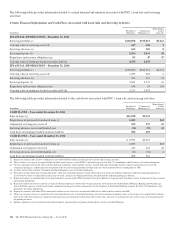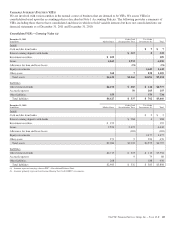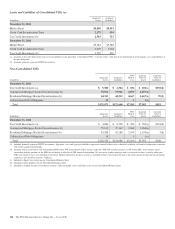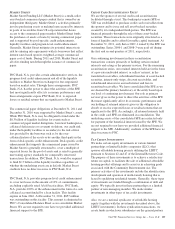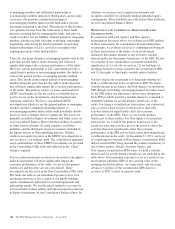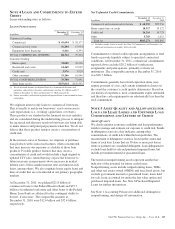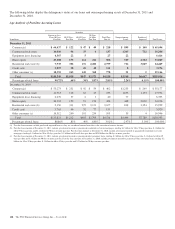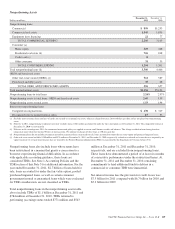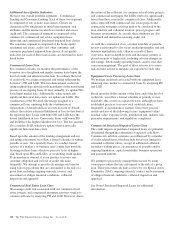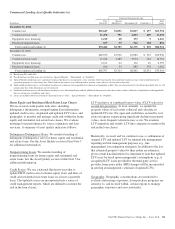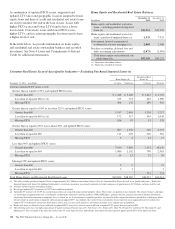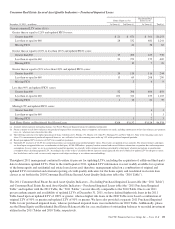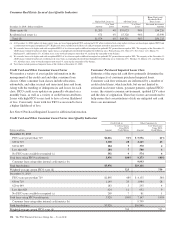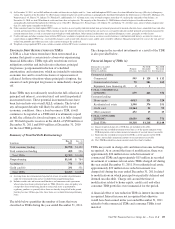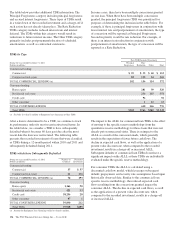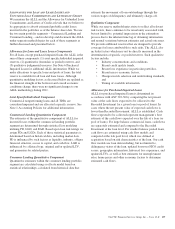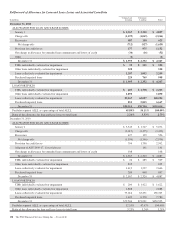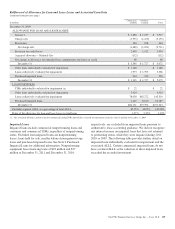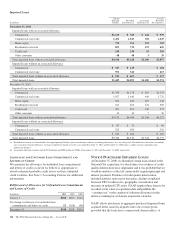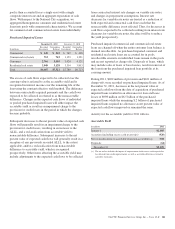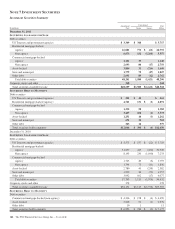PNC Bank 2011 Annual Report Download - page 141
Download and view the complete annual report
Please find page 141 of the 2011 PNC Bank annual report below. You can navigate through the pages in the report by either clicking on the pages listed below, or by using the keyword search tool below to find specific information within the annual report.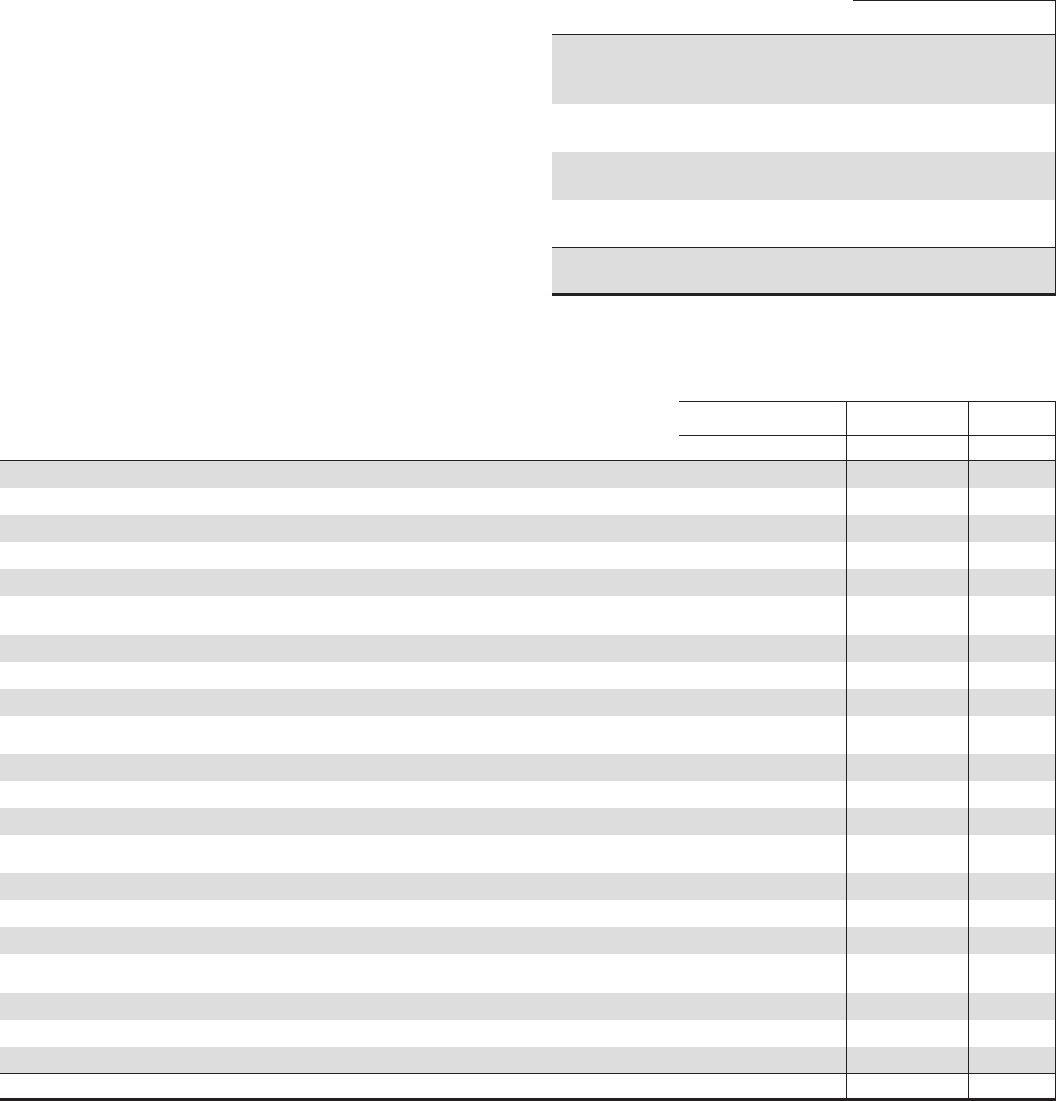
A combination of updated FICO scores, originated and
updated LTV ratios and geographic location assigned to home
equity loans and lines of credit and residential real estate loans
are used to monitor the risk in the loan classes. Loans with
higher FICO scores and lower LTVs tend to have a lower
level of risk. Conversely, loans with lower FICO scores,
higher LTVs, and in certain geographic locations tend to have
a higher level of risk.
In the table below, we provide information on home equity
and residential real estate outstanding balances and recorded
investment. See Note 4 Loans and Commitments to Extend
Credit for additional information.
Home Equity and Residential Real Estate Balances
In millions
December 31
2011
December 31
2010
Home equity and residential real estate
loans - excluding purchased impaired
loans (a) $41,014 $42,298
Home equity and residential real estate
loans - purchased impaired loans (a) 6,533 7,924
Government insured or guaranteed
residential real estate mortgages (a) 2,884 2,488
Purchase accounting, deferred fees and
other accounting adjustments (2,873) (2,485)
Total home equity and residential real
estate loans (b) $47,558 $50,225
(a) Represents outstanding balance.
(b) Represents recorded investment.
Consumer Real Estate Secured Asset Quality Indicators – Excluding Purchased Impaired Loans (a)
Home Equity (b)
Residential Real
Estate (b)
December 31, 2011 – in millions 1st Liens 2nd Liens 1st Liens Total (b)
Current estimated LTV ratios (c) (d)
Greater than or equal to 125% and updated FICO scores:
Greater than 660 $ 1,448 $ 3,488 $ 1,845 $ 6,781
Less than or equal to 660 (e) (f) 213 713 463 1,389
Missing FICO 494 135 289 918
Greater than or equal to 100% to less than 125% and updated FICO scores:
Greater than 660 1,017 2,864 1,336 5,217
Less than or equal to 660 (e) (f) 172 517 349 1,038
Missing FICO 186 87 53 326
Greater than or equal to 90% to less than 100% and updated FICO scores:
Greater than 660 687 1,350 760 2,797
Less than or equal to 660 111 205 200 516
Missing FICO 3 2 12 17
Less than 90% and updated FICO scores:
Greater than 660 7,190 7,888 3,152 18,230
Less than or equal to 660 1,080 1,102 799 2,981
Missing FICO 14 13 32 59
Missing LTV and updated FICO scores:
Greater than 660 92 11
Less than or equal to 660 2 1 3
Missing FICO 731 731
Total Home Equity and Residential Real Estate Loans $12,626 $18,367 $10,021 $41,014
(a) This table excludes purchased impaired loans of approximately $6.5 billion in outstanding balances (See the Consumer Real Estate Secured Asset Quality Indicators – Purchased
Impaired Loans table below for additional information), government insured or guaranteed residential real estate mortgages of approximately $2.9 billion, and loans held for sale.
(b) Amounts shown represent outstanding balance.
(c) Based upon updated LTV (inclusive of CLTV for second lien positions).
(d) Updated LTV (inclusive of CLTV for second lien positions) are estimated using modeled property values. These ratios are updated at least annually. The related estimates and inputs
are based upon an approach that uses a combination of third-party automated valuation models (AVMs), HPI indices, property location, internal and external balance information,
origination data and management assumptions. In cases where we are in an originated second lien position, we generally utilize origination balances provided by a third-party which
do not include an amortization assumption when calculating updated LTV. Accordingly, the results of these calculations do not represent actual appraised loan level collateral or
updated LTV based upon a current first lien balance, and as such, are necessarily imprecise and subject to change as we enhance our methodology.
(e) Higher risk loans are defined as loans with both an updated FICO score of less than or equal to 660 and an updated LTV greater than or equal to 100%.
(f) The following states have the highest percentage of higher risk loans: Pennsylvania 13%, New Jersey 13%, Illinois 10%, Ohio 9%, Florida 8%, California 8%, Maryland 5%, and
Michigan 5%. The remainder of the states have lower than 3% of the high risk loans individually, and collectively they represent approximately 29% of the higher risk loans.
132 The PNC Financial Services Group, Inc. – Form 10-K


